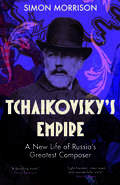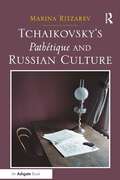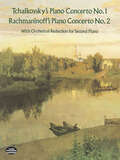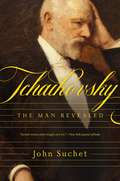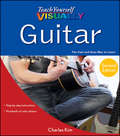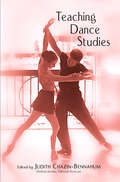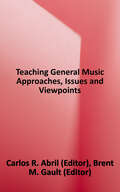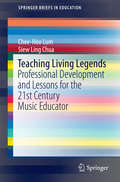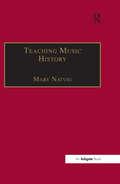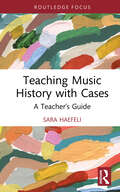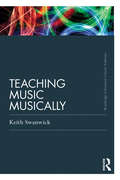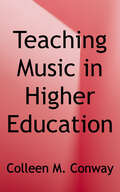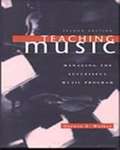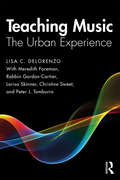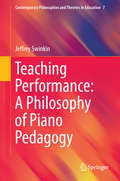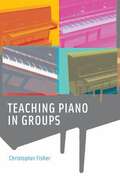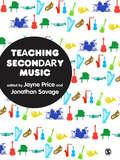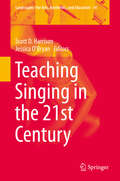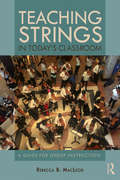- Table View
- List View
Tchaikovsky in America
by Elkhonon YoffeBiography of the famous composer, including his trip to New York in 1891 to celebrate the opening of Carnegie Hall.
Tchaikovsky's Empire: A New Life of Russia's Greatest Composer
by Simon MorrisonA thrilling new biography of Pyotr Ilyich Tchaikovsky—composer of some of the world&’s most popular orchestral and theatrical music &“A lively, argumentative and thoughtful reflection on one of the 19th century&’s most important musical figures.&”—Michael O&’Donnell, Wall Street Journal Tchaikovsky is famous for all the wrong reasons. Portrayed as a hopeless romantic, a suffering melancholic, or a morbid obsessive, the Tchaikovsky we think we know is a shadow of the fascinating reality. It is all too easy to forget that he composed an empire&’s worth of music, and navigated the imperial Russian court to great advantage. In this iconoclastic biography, celebrated author Simon Morrison re-creates Tchaikovsky&’s complex world. His life and art were framed by Russian national ambition, and his work was the emanation of an imperial subject: kaleidoscopic, capacious, cosmopolitan, decentred. Morrison reexamines the relationship between Tchaikovsky&’s music, personal life, and politics; his support of Tsars Alexander II and III; and his engagement with the cultures of the imperial margins, in Ukraine, Poland, and the Caucasus. Tchaikovsky&’s Empire unsettles everything we thought we knew—and gives us a vivid new appreciation of Russia&’s most popular composer.
Tchaikovsky's Pathétique and Russian Culture
by Marina RitzarevTchaikovskyʼs Sixth Symphony (1893), widely recognized as one of the worldʼs most deeply tragic compositions, is also known for the mystery surrounding its hidden programme and for Tchaikovskyʼs unexpected death nine days after its premiere. While the sensational speculations about the composerʼs possible planned suicide and the suggestion that the symphony was intended as his own requiem have long been discarded, the question of its programme remains.
Tchaikovsky's Piano Concerto No. 1 & Rachmaninoff's Piano Concerto No. 2: With Orchestral Reduction for Second Piano (Dover Classical Piano Music: Four Hands)
by Serge Rachmaninoff Peter Ilyitch TchaikovskyThis authoritative edition continues Dover's series of great piano concertos with orchestral reduction for second piano -- the universal standard, for students and professionals alike, for learning and rehearsing all concertos. Together for the first time are two of the most performed and recorded concertos of all time: the Tchaikovsky Piano Concerto No. 1 in G-flat Minor, Op. 23, and the Rachmaninoff Piano Concerto No. 2 in C Minor, Op. 18.Both of these great Russian works have achieved unrivaled worldwide popularity and are absolute musts in the repertoire of every serious pianist. The Tchaikovsky concerto combines a virtuoso piano part with brilliant orchestral scoring. The Rachmaninoff concerto is universally admired for the dark, brooding opening, enormously popular themes, and passionate, lyrical final movement. Every pianist and serious piano student will want this attractive and modestly priced edition.
Tchaikovsky: The Man Revealed
by John SuchetA tortured genius, a sensitive soul, and a great composer burdened by the weight of his private desires, Tchaikovsky’s life is explored in full by the incomparable John Suchet. Pyotr Ilyich Tchaikovsky is one of the most successful composers that Russia has ever produced, but his path to success was not an easy one. A shy, emotional child, intended for the civil service by his father, Tchaikovsky came late to composing as a career, and despite his success he was a troubled character. Doubting himself at every turn, he was keenly wounded by criticism. The death of his mother haunted him all his life and his incessant attempts to suppress his homosexuality took a huge toll. From Tchaikovsky’s disastrous marriage to his extraordinary relationship with his female patron, his many amorous liaisons, and his devotion to friends and family, Suchet shows us how the complexity of Tchaikovsky’s emotional life plays out in his music. A man who was by turns quick to laugh and to despair, his mercurial temperament found its outlet in some of the most emotionally intense music ever written.
Teach Yourself Basic Guitar
by Simon Pitt Simon TroupThe core information that you will learn in this book will be useful to you whichever styles of popular music you may later choose to specialize in. Whether you want to play rock, pop, blues, reggae, funk, folk or jazz, you'll need to start developing good left- and right-hand technique, and learn the chords and scales that are the building blocks of almost all western popular music. While this book doesn't go into any depth on classical guitar technique, there is a great deal of information and advice that will be of benefit to anyone who may decide that they wish to specialize in classical guitar playing in the future.
Teach Yourself Guitar
by Dale FraddTeach Yourself Guitar is an essential guide for anyone who wants to learn how to play this beautiful instrument. It will take you from choosing your guitar and tuning it, to reading the music and actually playing it.
Teach Yourself VISUALLY Guitar
by Charles KimEverything beginners need to know to start playing guitarDo you learn faster by seeing and doing than by wading through tedious instructions? Then pick up a guitar and start strumming! Teach Yourself VISUALLY Guitar shows you the basics--step by step and note by note. You begin with basic chords and techniques and progress through suspensions, bass runs, hammer-ons, and barre chords. As you learn to read tablature and lead sheets, you can play any number of songs and styles of music, from rock to folk to country. The chord chart and scale appendices are ready references for use long after you master the basics.Plus, this new edition includes an audio CD so you can hear what each note, chord, and technique should sound like, along with a new chapter on reading music.This new edition includes substantial improvements to get readers playing the guitar fasterA photo-intensive, step-by-step approach to playing acoustic and electric guitarThe bonus CD includes more than 100 audio tracksWhether you've never picked up a guitar or want to brush up on the basics, Teach Yourself VISUALLY Guitar will get you strumming in no time.
Teaching Dance Studies
by Judith Chazin-Bennahum Melinda JordanTeaching Dance Studies is a practical guide, written by college professors and dancers/choreographers active in the field, introducing key issues in dance pedagogy. Many young people graduating from universities with degrees – either PhDs or MFAs – desire to teach dance, either in college settings or at local dance schools. This collection covers all areas of dance education, including improvisation/choreography; movement analysis; anthropology; theory; music for dance; dance on film; kinesiology/injury prevention; notation; history; archiving; and criticism. Among the contributors included in the volume are: Bill Evans, writing on movement analysis; Susan Foster on dance theory; Ilene Fox on notation; Linda Tomko addresses new approaches to teaching the history of all types of dance; and Elizabeth Aldrich writing on archiving.
Teaching Electronic Music: Cultural, Creative, and Analytical Perspectives (Modern Musicology and the College Classroom)
by Blake StevensTeaching Electronic Music: Cultural, Creative, and Analytical Perspectives offers innovative and practical techniques for teaching electronic music in a wide range of classroom settings. Across a dozen essays, an array of contributors—including practitioners in musicology, art history, ethnomusicology, music theory, performance, and composition—reflect on the challenges of teaching electronic music, highlighting pedagogical strategies while addressing questions such as: What can instructors do to expand and diversify musical knowledge? Can the study of electronic music foster critical reflection on technology? What are the implications of a digital culture that allows so many to be producers of music? How can instructors engage students in creative experimentation with sound? Electronic music presents unique possibilities and challenges to instructors of music history courses, calling for careful attention to creative curricula, historiographies, repertoires, and practices. Teaching Electronic Music features practical models of instruction as well as paths for further inquiry, identifying untapped methodological directions with broad interest and wide applicability.
Teaching General Music: Approaches, Issues, and Viewpoints
by Carlos R. Abril Brent M. GaultGeneral music is informed by a variety of teaching approaches and methods. These pedagogical frameworks guide teachers in planning and implementing instruction. Established approaches to teaching general music must be understood, critically examined, and possibly re-imagined for their potential in school and community music education programs. Teaching General Music brings together the top scholars and practitioners in general music education to create a panoramic view of general music pedagogy and to provide critical lenses through which to view these frameworks. The collection includes an examination of the most prevalent approaches to teaching general music, including Dalcroze, Informal Learning, Interdisciplinary, Kodály, Music Learning Theory, Orff Schulwerk, Social Constructivism, and World Music Pedagogy. In addition, it provides critical analyses of general music and teaching systems, in light of the ways children around the world experience music in their lives. Rather than promoting or advocating for any single approach to teaching music, this book presents the various approaches in conversation with one another. Highlighting the perceived and documented benefits, limits, challenges, and potentials of each, Teaching General Music offers myriad lenses through which to re-read, re-think, and re-practice these approaches.
Teaching Living Legends
by Chee-Hoo Lum Siew Ling Ling ChuaThis book traces the research on the design, implementation and outcomes of a professional development program for in-service primary and secondary school teachers aimed at enhancing their understanding of living music traditions in Singapore and how these could be taught in the 21st century music classroom. It proposes a professional development framework comprising the areas of Pedagogy, Practice and Perspective to guide professional development design. The book also aims to promote further discussions on adult learning and teaching about teaching, especially with regard to developing self-efficacy to handle different music traditions in a 21st century, multi-ethnic society like Singapore.
Teaching Music History
by Mary NatvigUnlike their colleagues in music theory and music education, teachers of music history have tended not to commit their pedagogical ideas to print. This collection of essays seeks to help redress the balance, providing advice and guidance to those who teach a college-level music history or music appreciation course, be they a graduate student setting out on their teaching career, or a seasoned professor having to teach outside his or her speciality. Divided into four sections, the book covers the basic music history survey usually taken by music majors; music appreciation and introductory courses aimed at non-majors; special topic courses such as women and music, music for film and American music; and more general issues such as writing, using anthologies, and approaches to teaching in various situations. In addition to these specific areas, broader themes emerge across the essays. These include how to integrate social history and cultural context into music history teaching; the shift away from the 'classical canon'; and how to organize a course taking into consideration time constraints and the need to appeal to students from a diverse range of backgrounds. With contributions from both teachers approaching retirement and those at the start of their careers, this volume provides a spectrum of experience which will prove valuable to all teachers of music history.
Teaching Music History with Cases: A Teacher's Guide (Modern Musicology and the College Classroom)
by Sara HaefeliTeaching Music History with Cases introduces a pedagogical approach to music history instruction in university coursework. What constitutes a music-historical "case?" How do we use them in the classroom? In business and the hard sciences, cases are problems that need solutions. In a field like music history, a case is not always a problem, but often an exploration of a context or concept that inspires deep inquiry. Such cases are narratives of rich, complex moments in music history that inspire questions of similar or related moments. This book guides instructors through the process of designing a curriculum based on case studies, finding and writing case studies, and guiding class discussions of cases.
Teaching Music Musically (Classic Edition)
by Keith Swanwick'There are countless gems within these pages ... Swanwick seems to write from more experience as a musician and teacher than most others who write for this audience. There is a real sense of his having been there. - Patricia Shehan Campbell, Professor of Music, University of Washington, USA'... contains the essential and highly valued hallmark of
Teaching Music in American Society: A Social and Cultural Understanding of Music Education
by Steven N. KellySuccessful professional music teachers must not only be knowledgeable in conducting and performing, but also be socially and culturally aware of students, issues, and events that affect their classrooms. This book provides comprehensive overview of social and cultural themes directly related to music education, teacher training, and successful teacher characteristics. New topics in the second edition include the impact of Race to the Top, social justice, bullying, alternative schools, the influence of Common Core Standards, and the effects of teacher and school assessments. All topics and material are research-based to provide a foundation and current perspective on each issue.
Teaching Music in American Society: A Social and Cultural Understanding of Teaching Music
by Steven N. KellyTeaching Music in American Society, Third Edition, provides a comprehensive overview of social and cultural themes directly related to music education, teacher training, and successful teacher characteristics. Music teachers need to be not only knowledgeable in conducting and performing but also socially and culturally aware of students, issues, and events that affect their classrooms. This book is designed for educators seeking K-12 music teacher certification to teach in American schools. At the conclusion of each chapter is a summary of the chapter and a list of key items and people discussed, plus a series of related questions for students to consider. Current topics in the third edition include: • an emphasis on social justice, sensitivity to transgender students, and bullying, • the influences of social media, • a focus on urban music education, and • a new chapter on diverse learning. Further, recent policy issues are addressed in this new edition: • the evolution of the No Child Left Behind Act into the Every Student Succeeds Act, • the increasing emphasis on charter schools, the privatization of public school, • changes in how schools are assessed, and • changes occurring within the teaching profession—and how all of these affect developments in music education. A major structural change is the chapter on equality of education has been split into two chapters, providing a stronger focus on both educational equality and diverse inclusive learning.
Teaching Music in Higher Education
by Colleen M. ConwayWith five newly written chapters and sizable additions to nine original chapters, this second edition provides a welcome update to author Colleen M. Conway's essential guide. <p><p>In the book's new chapters, Conway offers insights beyond music and cognition including gender identity, sexual identity, and issues of cultural diversity not addressed in the first edition. Conway also covers technology in instructional settings and includes new references and updated student vignettes. <p><p>Designed for faculty and graduate assistants working with undergraduate music majors as well as non-majors in colleges and universities, the book is designed to fit within a typical 15-week semester. The book's three sections address concerns about undergraduate curricula that meet National Association of School of Music requirements as well as teacher education requirements for music education majors in most states. <p><p>Part I includes chapters on assessment and grading in music courses; understanding students' cognitive, musical, and identity growth; and syllabus design. Part II focuses on creating a culture for learning; instructional strategies to facilitate active learning; and applied studio teaching. Part III addresses growth in teaching practices for the college music professor and focuses on the job search in higher education, feedback from students, and navigating a career in higher education. The book features highly useful templates including a departmental assessment report, forms for student midterm and final evaluation, a Faculty Activities Report for music professors, and a tenure and promotion materials packet. <p><p>Each of the three sections of the book makes reference to relevant research from the higher education or learning sciences literature as well as suggestions for further reading in the various topic areas.
Teaching Music: Managing The Successful Music Program
by Darwin E WalkerThis practical text offers a comprehensive program for organizing and managing the non-instructional functions of a successful music program.
Teaching Music: The Urban Experience
by Lisa C DeLorenzoThis timely book explores teaching music in the urban setting along with interviews and journal accounts from urban music teachers in a variety of specializations. Written for pre-service music education students and music teachers new to urban teaching, this is a must-read for those considering teaching in the urban schools. Selected topics include culturally responsive teaching; White teachers working with students of color; nurturing pedagogy for at-risk youths; working with ESL students and immigrant families; creating a democratic and socially just music classroom; and developing habits of teaching that promote resilience and confidence in the emotional, social, and academic well-being of young musicians. A valuable resource for music teaching, this book features an accessible blend of theory and practice with authentic stories from the field.
Teaching Performance: A Philosophy of Piano Pedagogy
by Jeffrey SwinkinHow can the studio teacher teach a lesson so as to instill refined artistic sensibilities, ones often thought to elude language? How can the applied lesson be a form of aesthetic education? How can teaching performance be an artistic endeavor in its own right? These are some of the questions Teaching Performance attempts to answer, drawing on the author's several decades of experience as a studio teacher and music scholar. The architects of absolute music (Hanslick, Schopenhauer, and others) held that it is precisely because instrumental music lacks language and thus any overt connection to the non-musical world that it is able to expose essential elements of that world. More particularly, for these philosophers, it is the density of musical structure--the intricate interplay among purely musical elements--that allows music to capture the essences behind appearances. By analogy, the author contends that the more structurally intricate and aesthetically nuanced a pedagogical system is, the greater its ability to illuminate music and facilitate musical skills. The author terms this phenomenon relational autonomy. Eight chapters unfold a piano-pedagogical system pivoting on the principle of relational autonomy. In grounding piano pedagogy in the aesthetics of absolute music, each domain works on the other. On the one hand, Romantic aesthetics affords pedagogy a source of artistic value in its own right. On the other hand, pedagogy concretizes Romantic aesthetics, deflating its transcendental pretentions and showing the dichotomy of absolute/utilitarian to be specious.
Teaching Piano in Groups
by Christopher FisherThis book provides a one-stop compendium of information related to all aspects of group piano teaching. <p><p> Motivated by an ever-growing interest in this instructional method and its widespread mandatory inclusion in piano pedagogy curricula, the author highlights the proven viability and success of group piano teaching, and arms front-line group piano instructors with the necessary tools for practical implementation of a system of instruction in their own teaching. <p><p> Contained within are: a comprehensive history of group piano teaching; accessible overviews of the most important theories and philosophies of group psychology and instruction; suggested group piano curricular competencies; practical implementation strategies; and thorough recommendations for curricular materials, instructional technologies, and equipment. The book also addresses specific considerations for pre-college teaching scenarios, the public school group piano classroom, and college-level group piano programs for both music major and non-music majors. <p><p> This book is accompanied by an extensive companion website, featuring a multi-format listing of resources as well as interviews with several group piano pedagogues.
Teaching Secondary Music: Drama, Visual Art, Music And Design (Cross-curricular Teaching And Learning In-- Ser.)
by Jonathan Savage Jayne PriceDesigned to support teachers in developing new strategies and pedagogies for teaching music, and for teacher education students requiring a comprehensive overview of the subject Teaching Secondary Music provides a modern and accessible insight into the key issues in music education at secondary level. Focusing on the nature of musical understanding and how to facilitate and assess musical progress, the editors bring together a team of experienced music educators leading the programme of support for the new secondary curriculum. Supported with practical examples, case studies and resources exploring effective practice, Teaching Secondary Music covers the key concepts and approaches which underpin good practice in secondary music education. These include: -How music relates to other curriculum subjects -Ways of implementing newer aspects of the curriculum -The music industry and intellectual property rights -Working with a range of musicians -Using ICT as a tool for musical performance -Developing musical leadership This book is essential reading for PGCE Secondary music specialists and practising music teachers. Jayne Price is the Music Education Coordinator in the School of Education and Professional Development at the University of Huddersfield. Jonathan Savage is a Reader in Education at the Institute of Education, Manchester Metropolitan University.
Teaching Singing in the 21st Century
by Scott D. Harrison Jessica O'BryanThis volume brings together a group of leading international researchers and practitioners in voice pedagogy alongside emerging academics and practitioners. Encompassing research across voice science and pedagogy, this innovative collection transcends genre boundaries and provides new knowledge about vocal styles and approaches from classical and musical theatre to contemporary commercial music. The work is sure to be valuable in tertiary institutions, schools and community music associations, suitable for use by private studio teachers, and will appeal to choral leaders and music educators interested in vocal pedagogy. "I thoroughly enjoyed reading this book and I am confident it will help bring all aspects of vocal pedagogy firmly into the 21st century. Refreshingly, many different areas of pedagogy are included in the text so we can all work together to more fully understand the singing voice. Up to the moment research is included along with an exploration of the evolving contemporary styles of singing. Further, areas regarding teaching and curriculum in higher education are also reviewed. All in all, this text a crucial addition to a professional's vocal library. " Jeanne Goffi-Fynn, Teachers College, Columbia University, USA.
Teaching Strings in Today's Classroom: A Guide for Group Instruction
by Rebecca B. MacLeod<p>Teaching Strings in Today’s Classroom: A Guide for Group Instruction assists music education students, in-service teachers, and performers to realize their goals of becoming effective string educators. It introduces readers to the school orchestra environment, presents the foundational concepts needed to teach strings, and provides opportunities for the reader to apply this information. The author describes how becoming an effective string teacher requires three things of equal importance: content knowledge, performance skills, and opportunities to apply the content knowledge and performance skills in a teaching situation. <p>In two parts, the text addresses the unique context that is teaching strings, a practice with its own objectives and related teaching strategies. Part I (Foundations of Teaching and Learning String Instruments) first presents an overview of the string teaching environment, encouraging the reader to consider how context impacts teaching, followed by practical discussions of instrument sizing and position, chapters on the development of each hand, and instruction for best practices concerning tone production, articulation, and bowing guidelines. Part II (Understanding Fingerings) provides clear guidance for understanding basic finger patterns, positions, and the creation of logical fingerings. String fingerings are abstract and thus difficult to negotiate without years of playing experience—these chapters (and their corresponding interactive online tutorials) distill the content knowledge required to understand string fingerings in a way that non-string players can understand and use. <p>Teaching Strings in Today’s Classroom contains pedagogical information, performance activities, and an online virtual teaching environment with twelve interactive tutorials, three for each of the four string instruments.</p>

